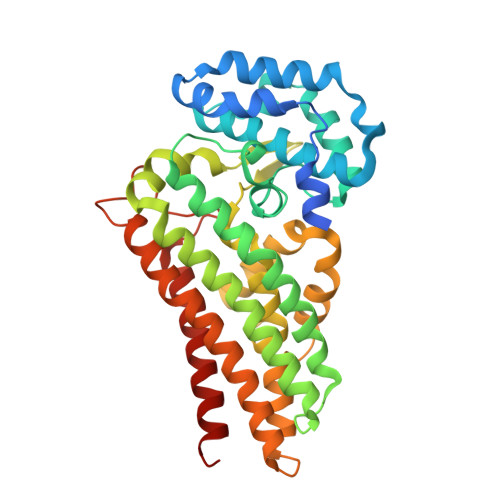Elucidating ligand interactions and small-molecule activation in the pyrrolnitrin biosynthetic enzyme PrnB.
Li, B., Usai, R., Campbell, J., Wang, Y.(2025) J Biological Chem 301: 108123-108123
- PubMed: 39725034
- DOI: https://doi.org/10.1016/j.jbc.2024.108123
- Primary Citation of Related Structures:
9DFG, 9DFI, 9DFL, 9DFM, 9EA1 - PubMed Abstract:
Pyrrolnitrin, a potent antifungal compound originally discovered in Pseudomonas strains, is biosynthesized through a secondary metabolic pathway involving four key enzymes. Central to this process is PrnB, a heme enzyme that catalyzes the complex transformation of 7-Cl-L-tryptophan. Despite its structural similarity to indoleamine 2,3-dioxygenase and tryptophan 2,3-dioxygenase and its classification within the histidine-ligated heme-dependent aromatic oxygenase superfamily, PrnB has remained relatively unexplored due to the challenges in reconstituting its in?vitro activity. In this work, we investigated the interactions of PrnB from different strains with its substrates, substrate analogs, and small molecules using various biophysical and biochemical techniques. Our spectroscopic data reveal that the substrate amino group directly coordinates with the heme in both oxidized and reduced enzyme forms. This binding conformation was further confirmed by X-ray crystallography of enzyme-ligand binary complexes. The amine ligation inhibits H 2 O 2 and CN - from interacting with the ferric heme but does not notably impact ? NO binding or O 2 activation by the ferrous heme. Stopped-flow spectroscopy showed the formation of heme-based oxidants similar to those reported in indoleamine 2,3-dioxygenase and tryptophan 2,3-dioxygenase when PrnB was exposed to H 2 O 2 or O 2 . However, these intermediates lacked catalytic activity, and PrnB was inactive when coupled with common redox systems under various conditions. This suggests that PrnB operates through a catalytic mechanism distinct from other heme-dependent aromatic oxygenases and most heme enzymes. Our study provides new insights into ligand binding and small-molecule activation mechanisms of PrnB, highlighting its unique functionality and distinguishing it from existing paradigms in heme catalysis.
Organizational Affiliation:
Department of Chemistry, University of Georgia, Athens, Georgia, USA.



















